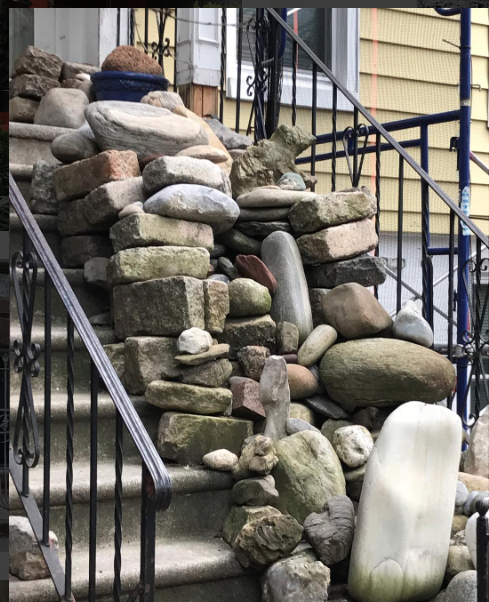Essay / AN EMPTY BEAN CAN
on home in temporary places

Photo: author’s archive.
„Originally home meant the center of the world—not in a geographical, but in an ontological sense. Mircea Eliade has demonstrated how the home was the place from which the world could be founded. A home was established, as he says, “at the heart of the real.” In traditional societies, everything that made sense of the world was real; the surrounding chaos existed and was threatening, but it was threatening because it was unreal. Without a home at the center of the real, one was not only shelterless but also lost in nonbeing, in unreality. Without a home everything was fragmentation.
Home was the center of the world because it was the place where a vertical line crossed with a horizontal one. The vertical line was a path leading upwards to the sky and downwards to the underworld. The horizontal line represented the traffic of the world, all the possible roads leading across the earth to other places. Thus, at home, one was nearest to the gods in the sky and to the dead of the underworld. This nearness promised access to both. And at the same time, one was at the starting point and, hopefully, the returning point of all terrestrial journeys.“ [1]
During the last few years, as I kept spending a large amount of time in new cities, all by myself in someone else’s apartments and rented rooms, during longer stays that offered to build some kind of a relation with a place, I started contemplating the verticality of home. Not as an archaic line connecting the man with heaven and hell, but as little, mundane moments that would cut across the horizon of my days, wide open and unpredictable.
One autumn day last year, as I was leaving my temporary, rented apartment in Lisbon, I thought: I conquered the door. After one week, I finally managed to close it with an unexpected ease. You know, the moment when you got it right. Which key goes where, how hard to pull and where to push so that the lock clicks with ease.
It was the day when the door finally stopped resisting, when the departure from and return to the house went smoothly. The day when my movements – my body – and my new surroundings began to collaborate. The moment when the place offered an inkling of home.
In Nida, it was not the door – it was an empty bean can placed in between them.
Bratislava – Vienna – Riga – Klaipéda – Smiltyné – Nida. An airplane, buses, ferry. After almost 19 hours journey, feeling starved to death, I bought a can of red beans at the local supermarket, the only one in the village, and prepared my first meal.
The kitchen had no windows, just doors that led to the patio, and they wouldn’t stay open. A few days later, when I felt the need to invent some sort of a ventilation system, I reached for the empty bean can, resting on the kitchen counter. It fit perfectly into the tight embrace of the door hinges, that would pressed it with their weight. Thus the bean can got a solid afterlife. We spent the following two months together – me and the can, whose metal body remembered the imprint of the door, quietly waiting for the next embrace. An improvised design of a temporary home.
I realised that there was something more to the act of placing an empty can inside the door frame, something beyond pure functionality. What might initially seem as a pragmatic and temporary solution had gained a new, almost symbolic meaning as the time passed. It was one of those subtle moments, a feeling of home in a temporary place. A moment of alignment with a space, a way, a gesture that allows us to take over a place, if only for a brief time – often even before we realise it. Tin can in the door. Postcard on the wall. First affair with a place. Trace after trace, creating the verticality of home.
In the Mongolian nomadic culture, the household has a precise physical arrangement that contrasts strongly to the constant change of place. Yurt is the centerpiece of the universe and, by its arrangement, it also embodies a microcosm. The entrance is oriented to the south, while the north interior is a special place reserved for sacred objects and honoured guests. The western side is intended for men and their hunting equipment, the eastern side is occupied by women and the kitchen. The internal division of the yurt is given, unchangeable, and the same for each family. The kitchen layout is also subject to a precise system. If a Mongolian woman visits another “household”, she will confidently reach for salt, as she knows exactly where she will find it.
A home, permanent or temporary, is not bound exclusively to the physical place, and solely to its physical interior that we are occupying. The essence of home is, more than anything, a system of customs and relationships in which they develop. The principle of repetition, of a ritual.
A notion home can therefore materialize in a window from which you observe the habits of others. Knowing that your neighbor will go out for a walk at a certain hour. Observing a tree crown changing throughout the year.
The moments in which we experience our relationship with a place are recognized and built inside our own interior, in our mental landscape. Over time, the vertical line may cross the horizontal, a ritual falls into it place. Over time, these moments form patterns that help us navigate one’s transient being in the world, in chaos.
To lie down on the floor of your apartment, feeling your body touching the firm ground, letting the verticality of your home pass through you.

Author unknown, source: internet.